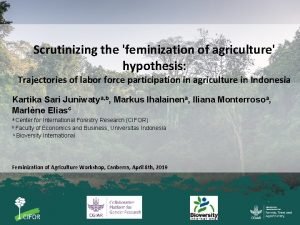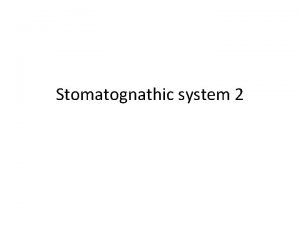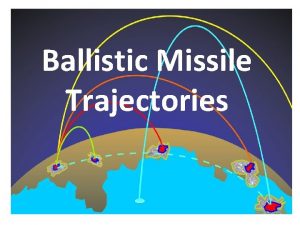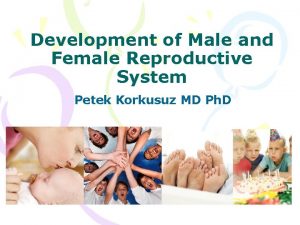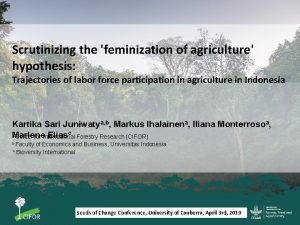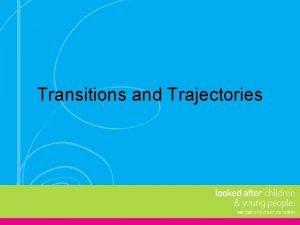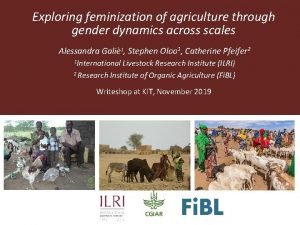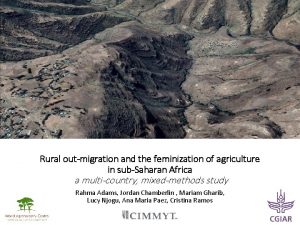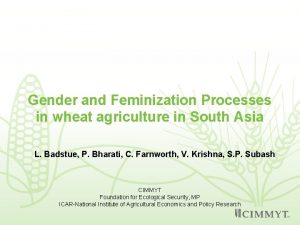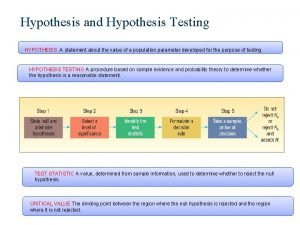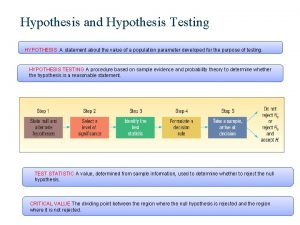Scrutinizing the feminization of agriculture hypothesis Trajectories of

















- Slides: 17

Scrutinizing the 'feminization of agriculture' hypothesis: Trajectories of labor force participation in agriculture in Indonesia Kartika Sari Juniwatya, b, Markus Ihalainena, Iliana Monterrosoa, Marlène Eliasc a Center for International Forestry Research (CIFOR) of Economics and Business, Universitas Indonesia c Bioversity International b Faculty Feminization of Agriculture Workshop, Canberra, April 8 th, 2019

Outline Background and relation to the Feminization of Agriculture theme Research problem and questions Methodology Timeline Potential cross-project synergies

Background and relation to the Feminization of Agriculture theme • Feminization of agriculture is widely used, interpretations vary o o Justification for targeting women in policy/programming Limited empirical evidence: risks perpetuating myths and masking differences among different groups of women and men • Indonesia: Dual objective to achieve food sufficiency and establish Indonesia as a global leader in biofuel production o o Despite still supporting 30% of Indonesia’s labor force, agriculture contributes only 13% of GDP Rapid expansion of biofuels contributing to transformation of rural landscapes and livelihoods, particularly for small-scale farmers

• Over the last ten years, national statistics show: o o Share of women in agriculture (relative to men): § 2008: 38. 79%, 2018: 37. 49% Share of agriculture in women’s total labor: § 2008: 42. 80%, 2018: 28. 39% • No significant differences in women and men’s overall participation in migration. However, gender influences migration patterns. • Aggregate data provides little support for feminization of agriculture –thesis. But what’s behind these numbers?

Research Questions • How has women’s and men’s participation in agriculture and forestry evolved in the past 20 years across Indonesia? o o Whether and to what extent has there been an increase in women’s participation (as farmers, wage workers) in agriculture and forestry between 1993 – 2014? How does women’s participation compare with their male counterparts’? Are men exiting agriculture and forestry sectors at a higher rate than women? Which sectors are they moving into? Who are the women and men who exit/stay? How is participation or non-participation related to various socioeconomic factors and processes over time (including ethnicity, household income, life cycle processes etc. )? How do changes in women and men’s participation relate to key land use trends?

Methodology: Mixed-methods Quantitative Analysis: Indonesian Family Life Survey (IFLS) 20 years of longitudinal data, rich in variables, high follow-up rate, and including split-off households Household level Sources: http: //www. smeru. or. id/sites/default/files/events/d 1_opening_ifls_firman_witoelar_0. pdf Individual level • Household Characteristics • Education • Farm Business • Subjective Wellbeing • Non Farm Business • Marital History & Pregnancy Summary • Household Assets • Household Decision Making • Non Labor Income • Economics Shocks • Migration • Consumption • Circular Migration • Employment & Retirement* • Knowledge on Family Planning Service • Risk and Time Preference* Trust* • Health & Community Participation Community level: Environtmental condition, employment, services, price, government programs, etc.

IFLS DATA – Individual – Labor Participation Section IFLS 1 1993 Current time and 5 years back: Work or not, working hours in normal week, working weeks in a year, primary duties, work status, gross profit, Primary job and additional job IFLS 2 1997 Current time and 10 years back: Work or not, working hours in normal week, working weeks in a year, primary duties, work status, gross profit, Primary job and additional job IFLS 3 2000 Current time and 4 years back: Work or not, working hours in normal week, working weeks in a year, primary duties, work status, gross profit, Primary job and additional job IFLS 4 2007 Current time Work or not, working hours in normal week, working weeks in a year, primary duties, work status, gross profit, IFLS 5 2014 Current time Work or not, working hours in normal week, working weeks in a year, primary duties, work status, gross profit, Primary job and additional job 10 years back- only primary Primary job and additional job 8 years back- only primary Termination, retirement, subjective assesment

IFLS DATA – HH Level – Farm Business Section IFLS 1 IFLS 2 IFLS 3 IFLS 4 IFLS 5 1993 Member work in farm business, ownership of farm business, percentage own by household, who own outside household, and who among the householders, and share percentage between head of HH and spouse, total value of production, total expenses, total net profit, farm business aset 1997 Member work in farm business, ownership of farm business, percentage own by household, who own outside household, and who among the householders, and share percentage between head of HH and spouse, total value of production, total expenses, total net profit, farm business aset Note: all questions are same with IFLS 1, but detail options of ownership. 2000 2007 2014 Own land, size land, member work in Own land, size land, number of plot, size farm business, size cultivated land, share largest plot, legal status of largest plot, cropped size, ownership of farm time earned title, ownership of Tanah business by hh. Bengkok, member work in farm which householder own business, size cultivated land, share valuable crops, total value of cropped size, size of cultivated land, size production, total expenses, net profit, of bengkok land cultivated, number of farm business asset harvest of main crops in the last 5 years, main crops, Note: share percentage between head Number of Rice harvest per seasons/last of HH and spouse has been dropped 12 months, for each harvest: time planted, time harvest, source of water, variety, areas harvested by HH, by other, amount of harvest, market price, give up for sharecropping Total value of production, expenses, and net profit Crop loss, reason of crop loss and approximate cost, farm business aset Livestock ownership, who take care of it, for how long, total value Note: significant additional detail Note: same as ILFS 4 questions in particular for rice production, crop loss, No. longer gender dimension

Sample size IFLS 1 IFLS 2 IFLS 3 IFLS 4 IFLS 5 1993 1997 2000 2007 2014 Households 7, 200 7, 600 10, 400 13, 500 15, 900 Individual 25, 000 31, 000 43, 000 50, 000 Year 16, 300 Statistical and Econometrics Analysis • Descriptive statistics • Regression • Cluster analysis

Dynamic of Households level participation in Agriculture 1993 N=7, 180 1997 N=7, 600 2000 N=10, 269 2007 N=12, 987 2014 N=15, 185 • Family exit indicidences are always higher than entry – except the period between 19972000 à The Asian financial crisis • Split households (mostly younger generation) enter more in non-farm than in farm N=19, 599 Households

Dynamics of household-level participation in Agriculture Zoom into household found in all 5 waves 1993 1997 2000 2007 2014 From 2, 415 agriculture households in 1993: • 6% moved out completely after the first round • 47% stay at least twice in any time – entry and exit • 47% of those doing farm business in 1993, stay for 20 years. N=5, 590 Households

Trajectories of women’s labor participation Retrospective data recorded in 2014 from Individual 15 years older in 2007 2008 2011 2014

Are women remaining in agriculture? 2011 vs 2014 Female exit from agriculture is mainly driven by exiting labor force – school or child bearing? Men 85. 31 Women 2. 46 81. 24 0% 20% 40% 10. 48 60% Agriculture, forestry, fisheries, hunting Manufacturing Wholesale, retail, restaurant, and hotels Social service Others Exit Labor Force 80% 100%

Complementary data analysis • IFLS data will be combined with CIFOR’s existing quantitative and qualitative datasets (tenure, migration, land-use, gender norms. . . ) in select geographies to understand trends and trajectories at the national level along with context-specific and nuanced analyses in specific contexts.

Timeline 1 2 3 4 5 6 7 8 9 10 2019 March Activity Preparing the IFLS data (quantitative) 11 12 2020 Apr Jun Jul Aug Sep Oct Nov Dec Jan Feb March Analysis of IFLS data Analysis of qualitative and spatial data Paper writing International conference Project Finalization

Potential Cross-project synergies • Spatial and gendered patterns of remaining or exiting agriculture and forestry • Drivers behind changing gender dynamics in agriculture, forestry • Intersectionality, life cycle analysis

THANK YOU cifor. org forestsnews. cifor. org Forests. Trees. Agroforestry. org
 Feminization hypothesis
Feminization hypothesis What is buccinator mechanism
What is buccinator mechanism Missiles have predetermined trajectories
Missiles have predetermined trajectories Orthogonal trajectories
Orthogonal trajectories Principal stresses in a beam
Principal stresses in a beam 5 major technological trajectories
5 major technological trajectories Testicular feminization syndrome
Testicular feminization syndrome Virilisation in females
Virilisation in females Androgen insensitivity syndrome
Androgen insensitivity syndrome Testicular feminization syndrome
Testicular feminization syndrome Process of discovery in reading
Process of discovery in reading Developing null and alternative hypothesis
Developing null and alternative hypothesis Null hypothesis
Null hypothesis Nebular hypothesis and protoplanet hypothesis venn diagram
Nebular hypothesis and protoplanet hypothesis venn diagram Example of null hypothesis
Example of null hypothesis Diễn thế sinh thái là
Diễn thế sinh thái là đại từ thay thế
đại từ thay thế Vẽ hình chiếu vuông góc của vật thể sau
Vẽ hình chiếu vuông góc của vật thể sau
